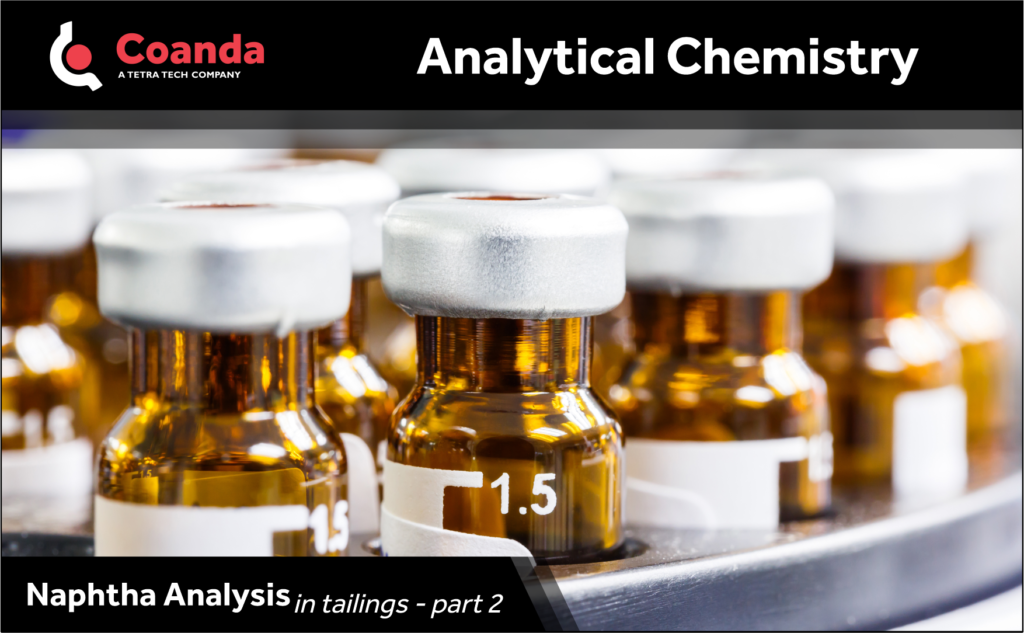Naphtha Analysis in Tailings
Posted on January 3, 2023 Analytical Chemistry Tailings
This post was originally published in two parts which have been combined below.
Part 1

Residual diluent in aqueous oil sands waste streams can be a potential issue for reclamation in oil sand operations. To ensure these waste streams have acceptable levels of diluent, a precise and accurate method to measure it is needed, which can also be used in an industrial analytical lab. One of the common diluents used in the oil sand industry is Naphtha, and it is particularly complex to quantify due to its ill-defined composition. Due to the complexity of the sample matrix and the different diluent compositions, reliable results are not easy to achieve.
Traditional diluent analysis is done by solvent extraction followed by Gas Chromatography (GC); however, extraction protocols utilizing tetra-hydro-naphthalene (THN) or Methanol tend to under-report the diluent content in the sample due to poor mass transfer during the sample extraction process. A more precise protocol used is the Vapour Flash Method, which subjects the sample to successive flashes at know temperatures and pressures. This produces condensed vapour which is then analyzed by GC, and requires a unique experimental apparatus known as the Vapour-Liquid Equilibrium (VLE) Apparatus. Unfortunately, the VLE does not support routine analytical turn-around-times due to the complexity of the apparatus and operational times required but is a great tool for validation and investigation purposes.
Utilizing existing protocol methodology of solvent extraction, Coanda improved the extraction procedure by tailoring the solvent used for extraction of an aqueous sample. By closing the gaps in sample extraction efficiency, better quantification resolution of diluent in tailings for routine analysis of tailings samples was achieved. The new extraction method yielded comparable results to those obtained with the Vapour Flash protocol without the need of special setups and complicated procedures, while adhering to existing data analysis techniques in similar turn-around-times to the traditional extraction and GC analysis.
Part 2

Naphtha composition can be quite variable and difficult to accurately quantify. For example, each of the petroleum hydrocarbon fractions (PHC) have a specific guideline for toxicological hazards, but when used to quantify diluent content, may under-report that content due to the diluent’s hydrocarbon complexity or because of sample extraction deficiencies when aligned with one specific PHC fraction.
To resolve extraction deficiencies and provide an accurate diluent content in tailings, we tailored the extraction solvents to the diluent of interest. By carefully selecting an adequate solvent for extraction and tailoring the analytical method for a specific diluent, precise determination of residual diluent in tailing streams can be achieved with some detection limits reaching less than 1 ppmw, including 0.6 ppmw for n-pentane and 0.4 ppmw for n-hexane. To achieve these results, the solvent selection must meet certain requirements including:
Ability to solubilize aqueous fraction without forming an emulsion,
Ability to completely solubilize bitumen fraction completing the hydrocarbon extraction,
Contain a low concentration of impurities,
Solvent interference/occlusion is minimized to ensure accurate definition of the diluent of interest in GC analysis
Recently our Dr. Cedric Laborde-Boutet presented The Characterization of Naphthenic Diluent in Oilsands Streams and Ponds at the 2022 International Oilsands Tailings Conference in Edmonton. His presentation details the process and reasoning behind developing the novel method for quantifying diluents in tailings waste streams. This method has been disseminated amongst COSIA, and is now offered by other analytical service providers as the go-to method for naphtha quantification. After the initial research on Naphthenic affected Froth Treated Tailings (FTT), supported by Coanda’s Analytical Laboratory, Dr. Laborde-Boutet has expanded this extraction-based protocol to other diluents of interest. This methodology has helped provide clear insights into evaluating biodegradation of naphtha, and has become a key method used for detailed hydrocarbon analysis of diluent in tailings.


